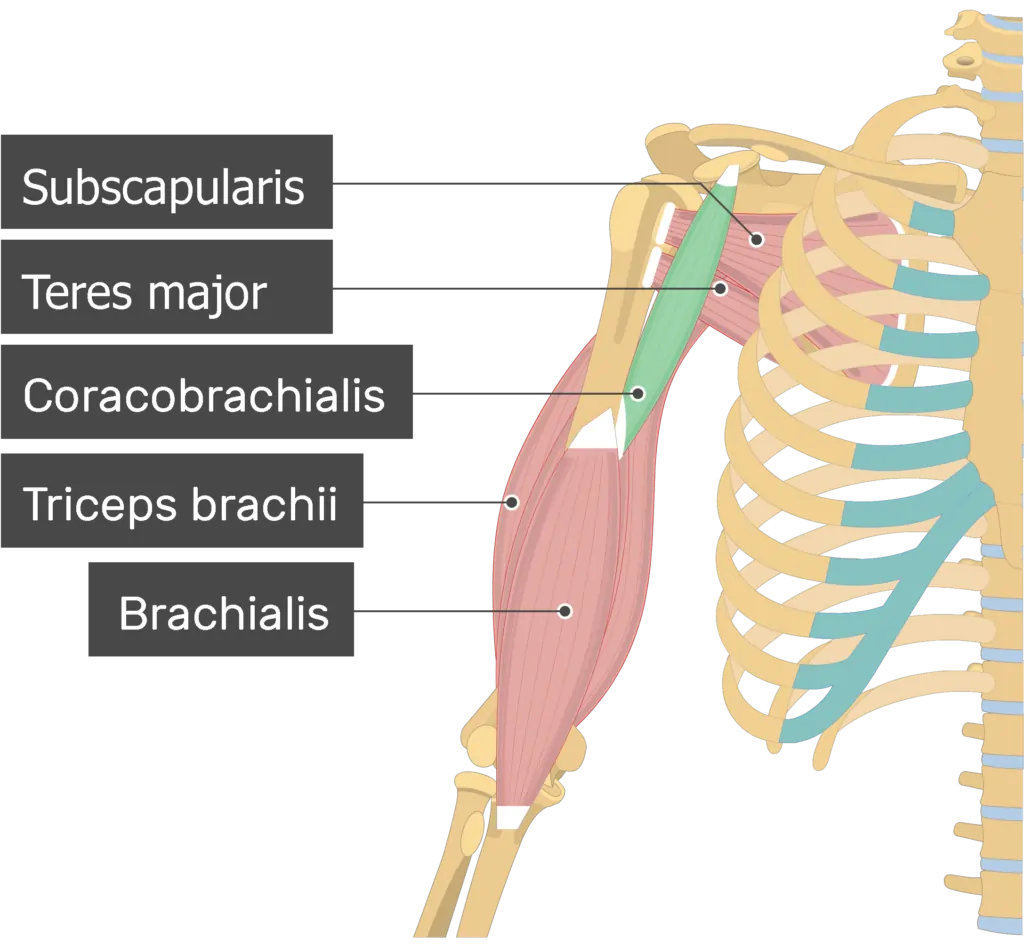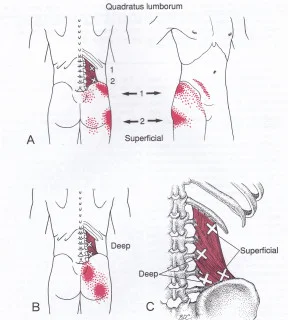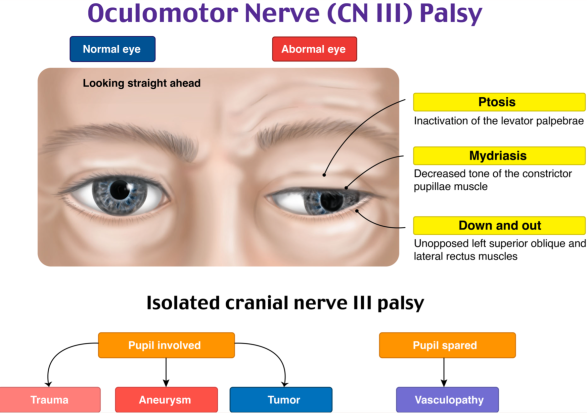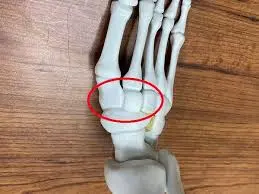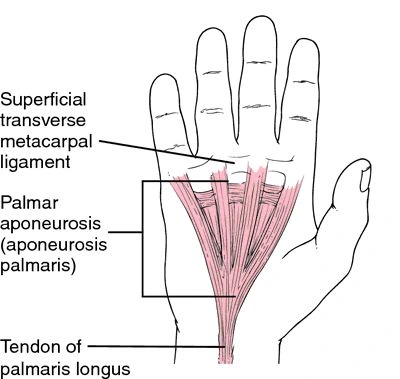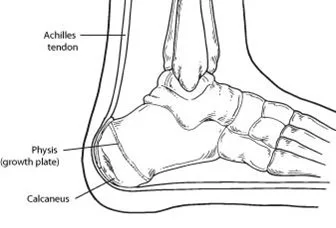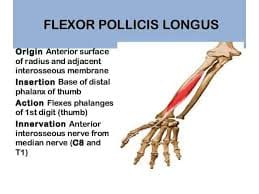Coracobrachialis
Introduction
The coracobrachialis muscle in the upper arm is small yet elongated. It’s situated in the arm’s anterior compartment. It starts from the scapula’s coracoid process and enters the centre of the humerus’s medial surface. Its main purpose is to flex and adduct the arm at the shoulder joint. It helps to keep the humeral head stable during shoulder movements.
Structure
Origin
Coracoid process of the scapula.
Insertion
Towards the humerus, the muscle fibers run inferolaterally. They inserted between the brachialis muscle and the medial head of the triceps on the anteromedial surface of the humeral shaft.
The coracobrachialis muscle enters the medial surface of the humerus, near the middle of the shaft.
Blood Supply
Brachial artery.
Nerve Supply
Function
The coracobrachialis muscle controls both shoulder flexion (bending) and adduction (moving the arm closer to the trunk). The coracobrachialis muscle strongly opposes the deltoid during arm abduction and extension.
Examination
Palpation
The therapist should passively flex the forearm at the elbow to prevent activation of the biceps brachii muscle and only allow contraction of the coracobrachialis, which is located beneath the short head of the biceps brachii. To be sure, ask the client to flex the elbow, which will demonstrate biceps brachii muscle contraction but not coracobrachialis. The therapist’s thumb should be placed on the arm’s upper and anteromedial sides, close to the armpit and between the biceps and triceps. Next, move the arm towards the subject’s body.
Strength
Isolating it for testing is challenging since it is not a primary mover, and other muscles may participate during testing. Grades 5, 4, and 3 should start in a sitting or supine posture with the arm extended and rotated externally at the shoulder joint, elbow in full flexion, and forearm supination, whereas grade 2 should be assessed while side-lying with the test arm uppermost, arm flexed, rotated externally at the shoulder joint, elbow in full flexion, and forearm supinated.
Clinical Importance
Any general muscle condition or injury can influence your coracobrachialis, although the majority are unlikely to. Because it is not as close to the surface, it is less vulnerable to damage than other muscles, and you usually don’t utilise it as frequently. However, sportsmen and those who work in industries that require repeated tasks may be more prone to overuse of the coracobrachialis muscle. Your coracobrachialis muscle is most likely to be affected by the following:
Repetitive strain injury. Excessive muscular use without adequate rest might cause strain. Muscle strains that do not heal properly might cause your muscles to harden and calcify.
Nerve entrapment. Numbness, tingling, and discomfort along the nerve’s path down your arm are indications of entrapment.
Common causes include bench pressing with exceptionally big weights, as well as carrying heavy loads with dangling arms. A common sign is discomfort in the arm and shoulder that radiates down to the back of the hand.
In more severe cases, the musculocutaneous nerve that passes through the coracobrachialis can become caught (entrapped). Clinically, affected individuals exhibit cutaneous sensory problems on the radial region of the forearm and decreased elbow flexion, as the nerve also feeds the biceps brachii and brachialis muscles. In contrast, a rupture of the coracobrachialis is highly rare and happens nearly exclusively in traumatic incidents.
Coracobrachialis pain
The term “coracobrachialis pain” usually describes soreness or discomfort in the little muscle on the inside of the upper arm, close to the shoulder. This muscle aids in the flexion and adduction of the shoulder. Activities involving repetitive arm movements, such as lifting or throwing, frequently cause pain, which can be caused by direct trauma, strain, or overuse.
Coracobrachialis Exercises
While it is not commonly isolated in workouts, the coracobrachialis is stimulated during movements that include shoulder flexion and adduction, particularly with the elbow flexed.
- Dumbbell Front Raise (with Elbow Slightly Bent)
- Hold one dumbbell in each hand while facing each other.
- Take the weights to shoulder height, keeping the elbow slightly bent.
- Resistance Band Shoulder Flexion
- Put a resistance band somewhere low.
- Hold the band with your palm up.
- Raise your arm forward to shoulder level, with your elbow slightly bent.
- Close-Grip Bench Press
- Brings the elbows closer to the body, resulting in greater arm adduction and shoulder flexion angles.
- While the triceps are the primary focus, the coracobrachialis also plays a role.
- Chin-Ups (Underhand Grip)
- The elbows move close to the torso, and the shoulder flexes when loaded.
- This activates the coracobrachialis, biceps, and lats.
- Cable Front Raise (Palms Up)
- Set the cable to the lowest position.
- Hold the handle with your palm up.
- Lift the arm in a controlled motion.
- This grip marginally activates the coracobrachialis.
FAQs
What causes pain in the coracobrachialis?
Chronic inflammation of the muscles and fascia can result from repetitive strain. This might result in chronic discomfort that is restricted to a hard knot or trigger point.
How to test the coracobrachialis?
The coracobrachialis is evaluated by aggressively flexing the arm in external rotation, with the forearm supinated and the elbow completely flexed. The biceps reflex might be reduced or not present. Sensory testing is of limited utility since full anaesthesia is uncommon.
What exercise works the coracobrachialis?
The coracobrachialis’ antagonist is the deltoid muscle. Exercises for the coracobrachialis include dumbbell bench press and bench rows.
What is the main function of the coracobrachialis?
The coracobrachialis muscle is located in the upper arm’s anterior (or front) compartment. The glenohumeral joint in the shoulder allows for both flexion (reducing the angle between the limb and joint) and adduction (moving towards the centre of the body).
How to palpate the coracobrachialis?
PALPATION: The coracobrachialis is situated at the front of the upper arm, between the anterior deltoid and the pectoralis major. It is located lateral to the anterior deltoid on the coracoid process. Palpate behind the coracoid.
References
- Coracobrachialis – 2022 https://teachmeanatomy.info/encyclopaedia/c/coracobrachialis/
- Coracobrachialis muscle – 2023 https://www.kenhub.com/en/library/anatomy/coracobrachialis-muscle
- Coracobrachialis muscle – 2024 https://en.wikipedia.org/wiki/Coracobrachialis_muscle
- Coracobrachialis muscle – 2025 https://my.clevelandclinic.org/health/body/coracobrachialis-muscle

